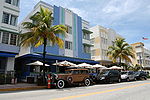Miami Beach Police Department

The Miami Beach Police Department is the police department of the U.S. city of Miami Beach, Florida, patrolling the entire Miami Beach area, although they sometimes cooperate with the county-wide Miami-Dade Police Department. The Miami Beach Police are famous for their bicycle patrols, which wear dark blue shorts and white short-sleeve uniform tops. The bicycle patrols were created due to the frequent traffic congestion of the Miami Beach isles (particularly in the famous Ocean Drive area on South Beach). Bicycle patrols go where patrol vehicles cannot, but they also perform traffic duties. There are even some patrol officers on roller skates. The Miami Beach Police wear dark blue trousers with dark blue shirts, and have red, white, and blue patrol vehicles however, the department is in the process of switching over to black and white patrol vehicles by the end of 2008. The current Chief of the Department is Chief Richard Clements.
Excerpt from the Wikipedia article Miami Beach Police Department (License: CC BY-SA 3.0, Authors, Images).Miami Beach Police Department
12th Street, Miami Beach
Geographical coordinates (GPS) Address Nearby Places Show on map
Geographical coordinates (GPS)
| Latitude | Longitude |
|---|---|
| N 25.782437 ° | E -80.133229 ° |
Address
12th Street 512
33139 Miami Beach
Florida, United States
Open on Google Maps










